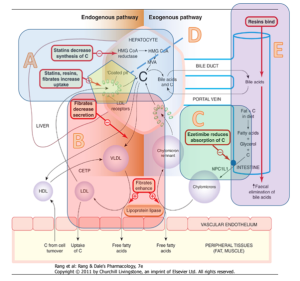2.22 Ezetimibe
John Smithson
Be able to:
- relate the mechanism of action of the fibrates to their cholesterol lowering effect
- understand the common and catastrophic side effects of the fibrate class
The brush border enzyme inhibitor, ezetimibe works by blocking the intestinal absorption of cholesterol. It achieves this by selectively inhibiting transport mechanisms within the brush-border surface of the intestinal epithelial cells, specifically targeting the Niemann-Pick C1-Like 1 (NPC1L1) protein. See action in part c of figure below.

As a result, when cholesterol absorption is reduced, the liver compensates by increasing the uptake of cholesterol from the circulation, thereby lowering serum cholesterol levels. When used as monotherapy, ezetimibe primarily reduces LDL cholesterol levels by up to 15-25%, with minimal impact on HDL and triglyceride levels. However, when combined with a statin, ezetimibe can produce an additional 20% reduction in serum LDL concentrations, along with a reduction in triglyceride levels and a slight increase in HDL levels.
Currently, ezetimibe is used in two main scenarios. First, it is used in combination with a statin in patients who have not reached their therapeutic goals with statin monotherapy. Second, it is used as monotherapy in patients who are intolerant of statin therapy.
Precautions
- Concurrent treatment with Fenofibrate
- Increased risk of gallbladder disease
- Hepatic impairment
- Manufacturer discourages usage in moderate/severe impairment
- Elderly
- Monitor carefully – some reports of depression in the elderly
- Pregnancy/Breastfeeding/Children – Currently no human data
Adverse effects
- Headache, diarrhoea
- Myalgia, Raised ALT/AST>3xULN
- Allergic reactions such as angioedema etc, pancreatitis, myopathy.
📺 Watch video: Ezetimibe pharmacology. (23.28 min)
COMMONWEALTH OF AUSTRALIA Copyright Regulations 1969 WARNING
This material has been reproduced and communicated to you by or on behalf of James Cook University in accordance with section 113P of the Copyright Act 1969 (Act).
The material in this communication may be subject to copyright under the Act. Any further reproduction or communication of this material by you may be the subject of copyright protection under the Act. Do not remove this notice.
